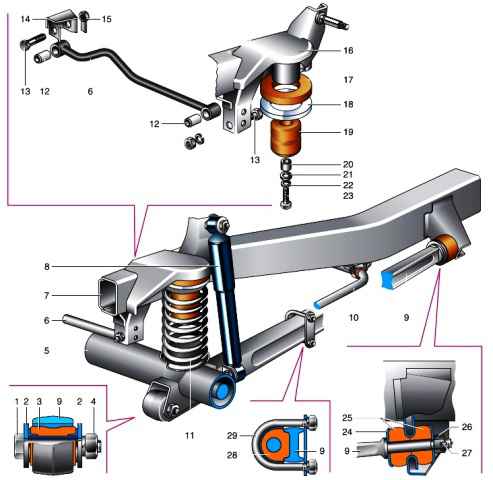A dependent front suspension of two types is installed on cars: spring or spring-lever
In the spring suspension, the rigid front axle is suspended from the frame side members on two eight-leaf springs

Front spring suspension: 1 - castellated nut; 2 - washers; 3 - axis of the front mounting of the spring; 4 - nut; 5 - rubber bushings; 6 - bracket for the front mounting of the spring; 7 - collar; 8 - spring; 9 - stepladder; 10 - overlay; 11 - rubber buffer; 12 - nut of the center bolt; 13 - frame spar; 14 - shock absorber; 15 - shock absorber bracket; 16 - upper shock absorber mount; 17 - bracket for the rear mounting of the spring; 18 - earring; 19 - spring washer; 20 - nut; 21 - rubber bushings; 22 - earring cheek; 23- fingers; 24 - lower shock absorber mount; 25 - lining; 26 - rear axle; 27 - ladder nut; 28 - cotter pin
Spring sheets are tightened with a center bolt and three clamps.
The root (top) sheet is thicker than the others.
The spring is connected to the bridge beam by two stepladders through an overlay and a gasket.
The front eye of the spring, formed by two upper sheets, is connected through two cylindrical rubber bushings to the axle installed in the front bracket.
The bracket is riveted to the frame side member.
The rear lug, formed only by the main sheet, is connected to the rear bracket through a double-hinged earring
The bracket is attached to the support with four bolts and nuts. Both earring hinges are also equipped with rubber bushings.
The link compensates for changes in the length of the spring when the bridge moves.
Rubber bushings ensure silent operation of the hinges without lubrication and maintenance.
Shock absorbers - hydraulic, two-pipe, with built-in rebound buffers.
The lower part (reservoir) of the shock absorbers is pivotally attached to the spring pads, and the upper part (stem) to the brackets welded to the frame spars.
The shock absorbers have rubber bushings.
Rubber buffers are bolted to the frame spars, limiting the upward movement of the bridge.

Front spring-lever suspension: 1 - bolt; 2 - bridge bracket; 3 - rubber-metal hinge; 4 - nut; 5 - front axle; 6 - transverse thrust; 7 - frame spar; 8 - shock absorber; 9 - front suspension arm; 10 - anti-roll bar; 11 - spring; 12 - rubber-metal hinges; 13 - bolt; 14 - transverse rod bracket; 15 - plate with a nut; 16 - spring bracket; 17 - pillow support; 18 - spring support; 19 - buffer; 20 - buffer sleeve; 21 - washer; 22 - spring washer; 23 - bolt; 24 - shaped washer; 25 - rubber pads; 26 - castellated nut; 27 - cotter pin; 28 - rubber bushing; 29 - ladder
In a spring-lever suspension, the front axle is suspended from the frame on two longitudinal forged levers, a transverse rod and two springs.
The suspension is equipped with a torsion-type anti-roll bar and twin-tube hydraulic shock absorbers
All joints and hinges are equipped with rubber bushings and cushions. Suspension brackets are welded to the frame.
Rubber buffers are installed inside the springs.
Possible suspension failures
Breakage of leaf springs (or springs)
- Operating the vehicle with overload or driving at high speed off-road
Replace broken sheets, spring (or spring)
- Loosening the nuts of the spring ladders
Tighten the ladder nuts
Large spring settling (or springs over 20 mm)
- Long-term operation of the car with overload or in difficult road conditions
Replace the spring (spring)
Squeak in suspension
- Lack of lubrication of leaf springs
Lubricate the leaf springs
- Wear of the rubber bushings of the springs or insufficiently tight fit
Replace worn bushings or increase their tightness
- Loose or worn spring suspension hinges
Tighten or replace hinges
Violation of the smooth operation of the suspension
- Liquid leakage through the stuffing box of the shock absorber rod and reservoir
Replace shock absorber





